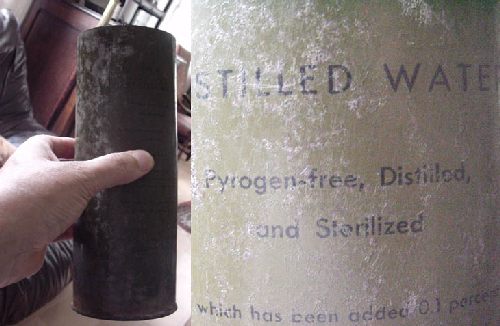|
This rusted tin container comes from the stocks of the US Army, a Luxembourgish farmer kept his rusty nails for years in it, and its medical significance emerges only from the printed text:
"600 cc
DISTILLED WATER
Pyrogenfree, Distilled, and Sterilized to 0.1 percent citric acid. Contains therefore sterile equipment to be used with the needles contained in the plasma can, for admi- nistering restored plasma.
See instructions for use and
diagrams on plasma can.
ELI LILLY AND COMPANY
Indianapolis U.S.A. "
The presented tin box once contained a glass bottle of sterile water and sterile material to be used in conjunction with a second, unshaped, mold-like jug containing the dried plasma and the transfusion needle, the whole for making and infusing so-called. "restored plasma", ie restored plasma.
"The package contained a waterproof fiberboard box, a rubber stoppered bottle of dried plasma, evacuated to 28 inches of vacuum, with the sterile, pyrogen-free equipment to be administered, contained in a sealed can After a few changes in the initial specifications, this package, which was first produced by commercial laboratories in 1941, was used with satisfaction throughout the war. "The first package was made up of dried plasma, with the appropriate amount of dilute fluid." "Late in 1943, the amount of plasma in each package was increased to 500 cc."
Source: history.amedd.army.mil/booksdocs/wwii/actvsurgconvoli/CH06.htm.
See also the picture: history.amedd.army.mil/booksdocs/wwii/blood/ch07fig42.jpg
The pharmaceutical company Eli Lilly has existed since 1876 and today produces the so-called "Humulin", a human insulin that is synthesized by bacteria.
|




